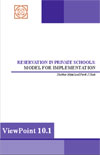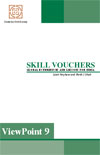| Research |
"They Say We're dirty" Denying an Education to India's Marginalized
Human Rights Watch
April 2014
Abstract: The teacher always made us sit in a corner of the room, and would throw keys at us [when she was angry]. We only got food if anything was left after other children were served…. [G]radually [we] stopped going to school. — Shyam, 14, Dalit boy from Uttar Pradesh now working at a brick kiln, April 2013.
In 2009, India enacted the Right of Children to Free and Compulsory Education Act, which provides for free and compulsory education to all children aged 6 to 14 based on principles of equity and non-discrimination. For a country that six decades ago at independence had staggering poverty and illiteracy levels, this was an overdue but ambitious step to meet its domestic and internationally recognized obligations to its children. It also testified to India’s increasing confidence as an emerging economy with one of the youngest and largest work forces in the world.
However, four years after it came into force, the Right to Education Act is yet to be properly implemented.
... read more |
| Education News |
| |
In India’s Schools, Discrimination Drives Dropouts
- The Wall Street Journal, 22 Apr 2014
RAMPUR, India—At the government school in this north Indian village, 8-year-old Dilip Banwasi is being taught his place. His third-grade teacher makes him sweep the classroom floor and sit in the back row. |
Only 4% EWS parents aware of reservation under RTE Act: Study
- The Indian Express, 26 Apr 2014
Only four per cent of parents from economically weaker sections (EWS) are aware about the availability of 25 per cent seats under EWS category in the capital’s private schools, under the RTE Act, a study has shown. |
Education startups eye big business in rural areas
- Economic Times, 24 Apr 2014
PUNE: Providing educational services to low income communities is proving to be good business for several startups that are launching innovative business models and reach out to rural consumers as well. These ventures are offering a range of services from pre-school classes, language lessons and online learning material delivered for free. |
Head Start, Meet Accountability
- The Atlantic, 24 Apr 2014
Head Start, the federally funded preschool program for low-income children, has experienced more change in the past three years than in the previous 40. After years of debate about the program's quality and value, there's an accountability revolution coming to preschool. |
Sarah Hardjowasito: A student’s view of quality education
- The Province, 27 Apr 2014
In an age of distractions and shortcuts, it is difficult to get students engaged and caring about learning. They languish in agony, waiting for the bell to free them from the classroom, so that they can return to the comforting blue glow of their phones. This only encourages a future society of self-absorption and obliviousness to the surrounding world. |
Should Students Sit on School Boards?
- The Atlantic, 23 April 2014
For centuries, students have been agents of social change, their passion and idealism forming a critical part of the historical landscape; a lesson that, in education, teachers and administrators ignore at their peril. But figuring out how best to appropriate student interests raises difficult questions. Do students belong on school boards? |
|
|
|
Poll
Should private schools have a 'salary according to fee' model for teachers?
To vote click here.
|
|
|
Factoid
India's literacy rate in 1947, when the country gained independence, was 14 percent and the female literacy rate was 8 percent. Today, India's literacy rate is 74 percent and the female literacy rate is 65 percent. Source: Human Rights Watch
|
|
Publications
 
|
| |
|
|


